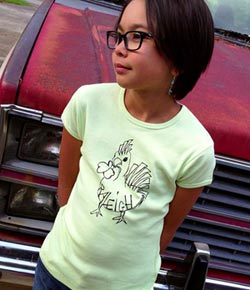It seems like winter will never end this year, but we were granted a rare Spring-like day last week. I furiously caught up on neglected yard work, and then rewarded myself by sitting down in my favorite yard chair to catch up on another seasonal pursuit–chicken-watching! My chickens seemed to be enjoying the brilliant sun, too, so I released them from the small pen surrounding their coop, and watched as they shot into a larger run, jockeying for position to spot the first insect or microscopic, green shoot.
One hen, in particular, caught my eye. She was poking about near an area where I had mended a hole in the fence last fall. Winter’s ravages had dealt a blow to my hasty repair, and left a tiny opening. Driven by greed or curiosity, she eyed the hole and explored it with her beak. Slowly, she stuck her beak through, and then her neck, moving in and out, in and out, first tentatively, then over and over with more excitement until finally–her “Eureka” moment–she bravely pushed through the opening and into the yard and freedom. She scratched furiously at the new terrain and was immediately rewarded with a juicy worm, cold-stunned and easy to snatch, the likes of which she hadn’t seen in five months.
The other chickens set up a chorus of clucks and agitated chatter as they ran along the fence line–convicts left behind. One by one, in turn, each discovered the small opening, repeated her actions, and made their escape, though none were rewarded with a worm. Some were tentative, some more bold and quick to act. One poor girl lingered for a good five minutes, unable to summon the courage or smarts to accomplish a quick get-away, but eventually even she made her way through the forbidden portal.
Watching my chickens accomplish what appeared to me to be a fairly complex task– involving exploration, group communication, and–dare I say it–thought–got me to thinking for the umpteenth time about chicken intelligence. Human-kind has been pretty slow to explore the intelligence of domestic poultry, and this has led us down a path of increasing acceptance of possibly inhumane methods of poultry production, with no hard and fast data supporting whether chickens suffer in confinement facilities, aka ‘factory farms.’ Research studies support what my chickens just showed me–that chickens can learn by observation. And while it is the rare chicken that will garner a starring role in Hollywood, research is beginning to uncover the complexity of their communications and behavior. (For a great, easy-to-read introduction to the studies being conducted on chicken behavior, check out ‘About Chickens’ on the Humane Society International website).
Interestingly, when let out into the pen the next day, the hen who garnered the prized worm immediately ran to the weak area in the fence, where she searched in vain for the hole (which I had fixed). The others–who hadn’t found a tasty reward on the previous day’s adventure–ignored her actions as if to say, “ho hum…nothing of interest out there.” Was her interest due to instinct? Intelligence? Was it random? At this point, science doesn’t completely know the answers to these questions, but until we are sure, I believe chickens–and all animals–deserve our respect, and a chance to live a comfortable life in a reasonably natural environment, eating the types of foods their species has been eating for millennia. In other words, they deserve the chance to behave like, well….chickens.
iNicol CJ and Pope SJ. 1992. Effects of social learning on the acquisition of discriminatory key pecking in hens. Bulletin of the Psychonomic Society 30(4):293-6.
iiAs viewed at: www.hsi.org/assets/pdfs/about_chickens.pdf





 On our site we now have an
On our site we now have an 